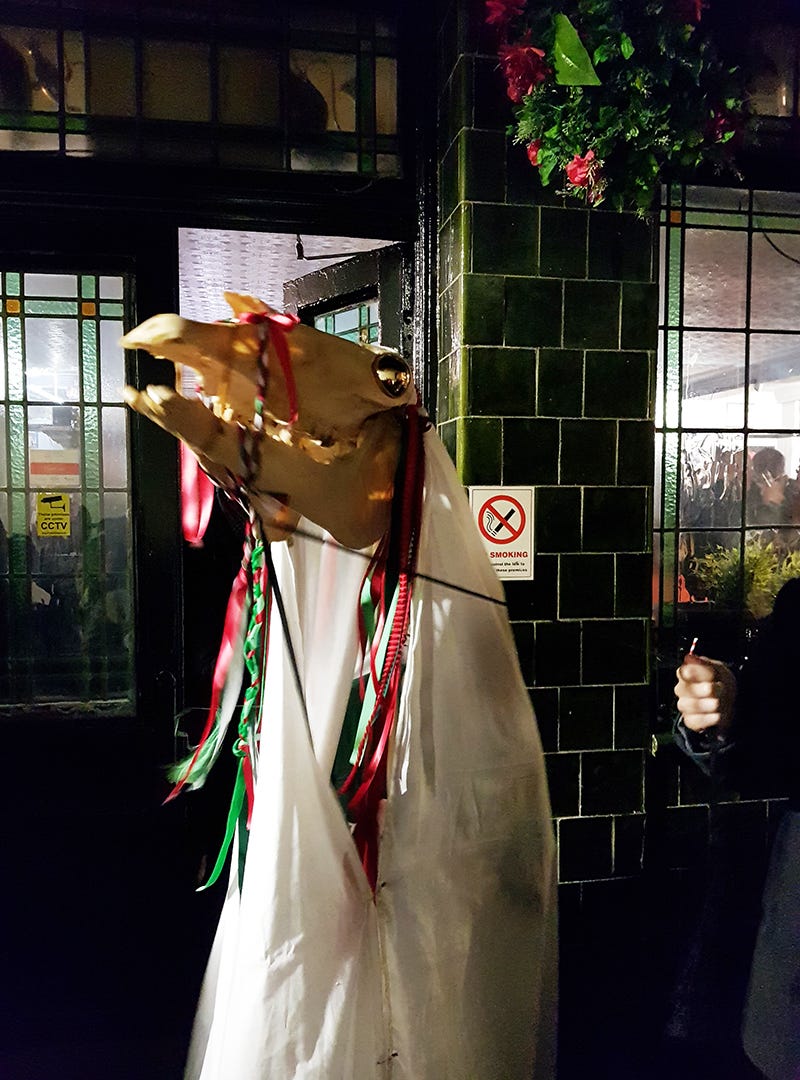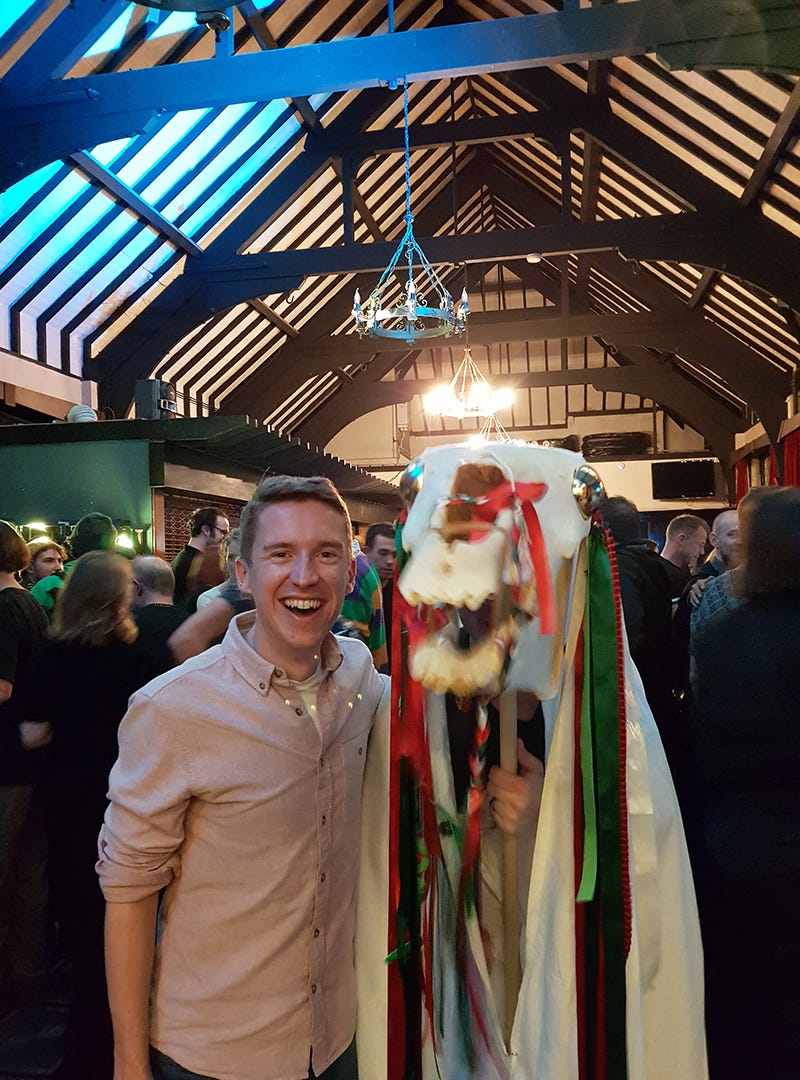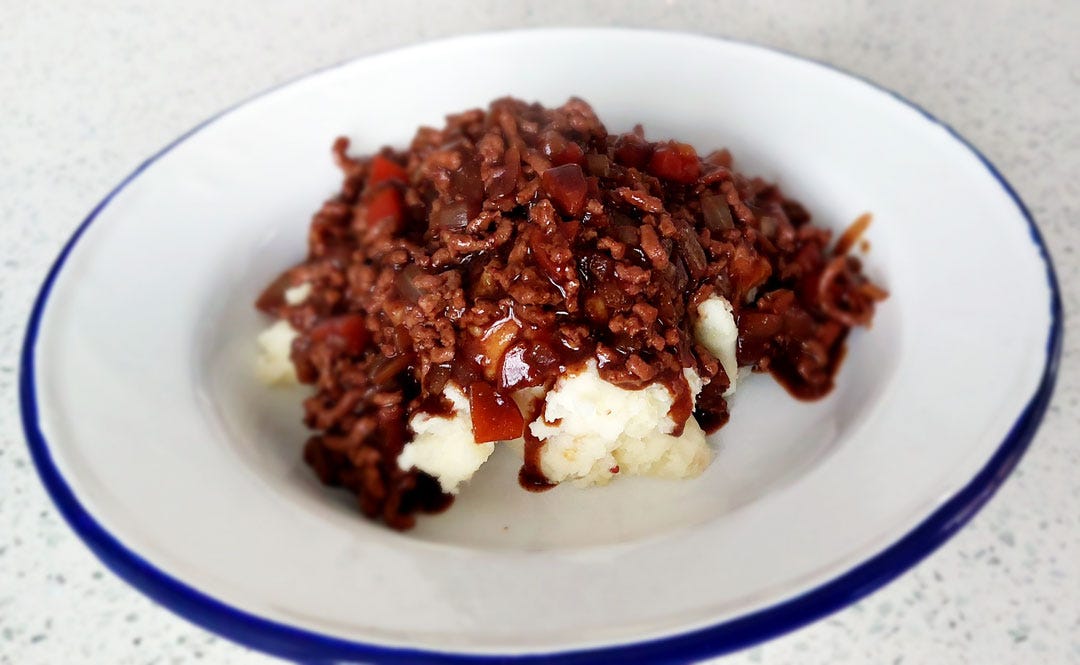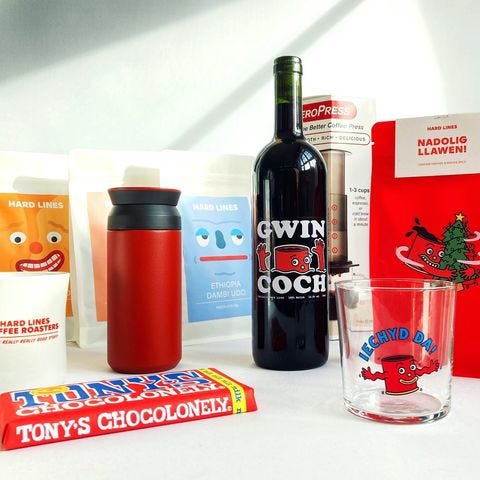There are many weird and wonderful traditions and customs in Wales – carving a spoon out of wood to show someone you love them for instance – but there’s one that for me is by far the oddest: the Mari Lwyd.
If you find yourself in some parts of Wales (and nowadays across the world where there’s a Welsh community) just after New Year, and you’re staggering home after a few drinks and you start seeing an eerie white animal skull coming towards you with a group of people singing, you have not had more to drink than you thought and you are not hallucinating. You are witnessing the custom of the Grey Mare (Mari Lwyd) – a form of wassail, where participants go from house to house (or pub to pub) trying to gain entry (and get something to eat or drink) by triumphing over the residents in a singing/poetry competition. But what about the skull?
Well, you take the skull of a horse, cover it in a white sheet like a ghost, hang colourful ribbons and bells off it and put it on a broom handle. Then someone slips under the sheet and carries Mari around, moving its mouth and causing general mischief. Never turn your back on Mari as she will give you a nip with her teeth if you’re not careful.
I’ve only ever participated once in the tradition and that was in London. The London Welsh Centre has organised a Mari Lwyd nearly every year since 2016 (sadly not for the last two), and in 2020 I went along. Trying to explain it to the people in the office was one thing, seeing the bemused looks on the faces of Londoners and tourists as a 40-strong crowd of people moved from pub to pub following a horse’s skull draped in a sheet was quite another. Welsh people never need an excuse to sing, so Mari had to make several attempts to get into each watering hole, but she finally made it in. At the end of the route we found ourselves in the Welsh Centre bar where the singing and dancing continued into the wee small hours.
Talking of yearly traditions, I can’t quite believe that the Welsh Kitchen newsletter is already a year old! I started it during lockdown as a way to share my love of food and my homeland and give myself a weekly writing project to fill my hours at home. I didn’t know if people would even sign up, let alone read it, so it’s been rather overwhelming and joyful to hear and read such lovely things from people who enjoy receiving it and cooking the recipes. I hope I bring a little touch of Wales to your inbox.
That said, things have got somewhat busier since the start of last year, and I’ve decided to make the free emails monthly this year rather than weekly. There will be some extra posts in between for paying subscribers and I’m hoping to further develop what the newsletter is and does. Thank you so much for your support over the last year, diolch yn fawr iawn.
The Recipe
Nanna Harris’s mash, mince and gravy
Firstly, Nanna Harris was my great-grandmother. She died a long while before I was born, but I feel a connection to her thanks to the stories told to me by my Nannie Gwen and my other great-aunties and uncles. One thing that comes up whenever I ask about food in Nanna Harris’s kitchen is her minced beef. The conversation usually goes something like this:
“What was your favourite thing that she cooked?”
“Her mince. It was absolutely delicious!”
“What was it like, how did she make it?”
“Ooohh I’ve no idea, but it was gorgeous”
Helpful, I’m sure you’d agree. However, My Nannie Gwen used to do what I think was very similar. She’d get the old cast iron mincer out of the cupboard, clamp it to her wooden ironing board, pop a plate underneath and feed through cuts of beef, or more likely the leftover beef from Sunday’s roast. My brother and I would have fun turning the handle. She’d then make a gravy with the beef and onions, and serve it over buttery mashed potatoes with sausages cooked in lard and marrowfat peas from a tin. It was the perfect mid-week cooked dinner. If she couldn’t be bothered with the mincing part, she’d buy a tin of minced beef in gravy instead, but she’d always add bits to it including gravy browning, so it was nearly black when it arrived on our plates.
My Uncle Graham (Nannie Gwen’s brother) told me the way he makes it and how he thinks Nanna Harris might have made it: browning the beef, chopping carrots and onions, adding stock and bubbling away. With all these nuggets of info, I’ve tried to recreate what I think Nanna Harris’s version might have tasted like (albeit with a few of my own embellishments).
Ingredients (serves 4)
Butter
4 medium carrots, finely chopped
2 medium onions, finely chopped
500g minced beef (or lamb or Quorn or other non-meat substitute)
1 ½ tsp brown sugar
¼ tsp ground mace (or allspice)
¾ tsp ground white pepper (or black pepper)
2 tbsp flour
Bay leaf
100ml red wine (optional)
500ml beef stock (made with two stock cubes)
Splodge of tomato puree (optional)
1 tsp gravy browning
4 large potatoes, roughly chopped
1 ½ tsp wholegrain mustard
Method
Melt a knob of butter in a large frying pan over a medium heat and add the carrots and onions. Soften for 10-15 minutes and then remove to a bowl and set to one side.
To the same pan, break in the minced beef and stir. Add the brown sugar, mace and pepper and mix. Cook for a few minutes until the meat is nicely browned.
Return the softened vegetables to the pan and stir. Sprinkle over the flour and mix before adding the bay leaf.
Turn the heat up and add the wine (if using), stock, tomato puree and gravy browning and stir well. Bring to the boil and then turn down to a simmer. Add more water if the gravy becomes too thick or reduces too much. Taste for seasoning and adjust as necessary.
Meanwhile, place the potatoes in salted water and bring to the boil and simmer for 15-20 minutes until softened.
Drain the potatoes and mash, along with a good knob of butter and the wholegrain mustard.
Pile up the mash in a dish and spoon over the mince and gravy. Sprinkle with more white pepper if you like it punchy.
If you try the recipe out, don’t forget to tag any photos with #mywelshkitchen.
The Playlist
To me, cooking and music go hand in hand, whether that’s singing at the top of your voice using a wooden spoon as a microphone while waiting for pasta to boil, or dancing around with the oven gloves on as the oven timer counts down. Here are this week’s ideas for your Welsh Kitchen playlist.
Let’s start the year off as we mean to go on with these two powerhouse performances from birthday girl, Dame Shirley Bassey, who celebrated her 85th birthday yesterday. The first is from her Electric Proms concert, the second from a celebration of Sir Bruce Forsyth.
I’m Still Here by Dame Shirley Bassey
Almost Like Being In Love by Dame Shirley Bassey
The Pantry
Good food is nothing without good ingredients and thankfully there are plenty of fantastic Welsh products on the market. Here is where you’ll find recommendations to stock up your cupboard, fridge or fruit bowl, or a really great place for food.
Iechyd Da glasses and Gwin Coch
I’m always looking for cool bits to brighten up my kitchen I loved these glasses from Cardiff coffee creators, Hard Lines, as soon as I saw them. They are sort of large tumbler size, ideal for beer, water or wine. Talking of wine, the company also recently released its own wine, Gwin Coch. It’s 100 per cent merlot from Italy, and has gorgeous red fruit and plum flavours with a slight tartness – and its definitely gluggable. I think it would suit being chilled ever so slightly and it would be great for a summer barbecue.







